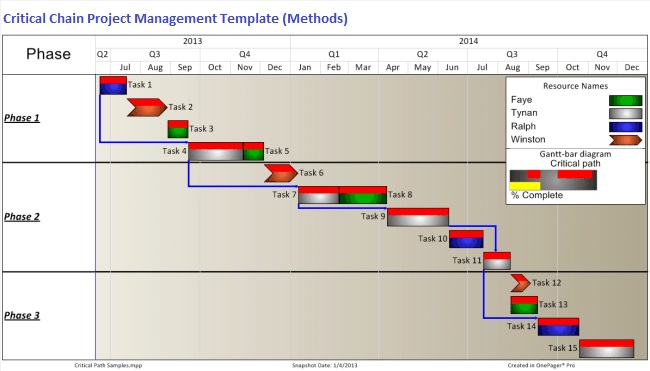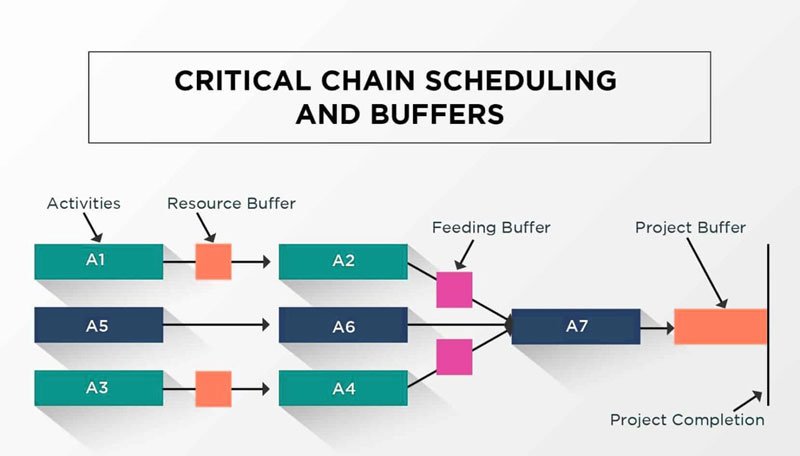Critical chain project management (CCPM) can be explained as a process of managing and planning the projects with particular stress on resources and tasks whose execution is essential for the completion of the project. In applying this methodology to the project, the project manager focuses the most on resources in the critical path.
Thank you for reading this post, don't forget to subscribe!This chain is the biggest in the network diagram that is a visual display of every single task required to accomplish the task.
This method of management is quite different from the traditional ones like those based on critical path management or PERT algorithm as these procedures provide rigid scheduling and inflexible task orders. The critical chain method is more focused on the balanced availability of resources and allows some flexibility at the beginning of the project.
It helps in hampering the cost overruns by reducing the chances of changes in the project and well schedule. It promises to extract more appreciable outcomes by altering the project management and control in project planning.
One of its aims is to draw out enhanced activity from the team members and other related staff. Resources constraints can also be decreased by opting for this method and efficient control over the project it also uses buffers.
Functions Of Critical Chain Project Management
The critical chain project acknowledges the task requirements and resources very well as a result the project is generally completed without any obstacle. In order to ensure that this method works, you have to fulfill the below mentioned responsibilities:
- An initial meeting for a preliminary discussion about the project.
- Pen down any new important details.
- Design the project and analysis of previous experiences.
- Assess quality assurance.
- Release as a beta-feature
- Introduce changes if required and upgrade the plan based on the feedback.
- Work on the features of the deliverable in order to enhance quality.
Key Features Of Critical Chain Project Management Template
The most eye-catching element of using this methodology is that it allows you to plan your project without any impendence of the resources. Moreover, another important feature is that procedure can track and control the likelihood of risks. According to research, this is a better method to adopt in comparison to the critical path technique.
Time management is another very useful attribute of critical chain management and also assists in identifying and rectifying any buffer in the system. Your desired project can be achieved with the utilization of this wonderful template.
Stages Of Critical Chain Project Management CCPM

There are 3 stages in this method:
- STAGE 1—PLANNING:
Begin with the last date of the project and start planning backward so that even the minute tasks could be identified that are essential for the execution of the project successfully. In addition to that also keep in mind the time duration required to finish the tasks.
Learn More: Project Planning
After that, you need to decide the type and quantity of resources for the completion of each task. Having all data gathered, now reconsider the time proportions required for caring out the sub-tasks as well as make certain that resources are adequate against the demand at every stage. This chain is the most extended sequence of tasks that ensure equilibrium between available resources and demand.
- STAGE 2—EXECUTION
After deciding the parameters of time for the propagation of the project (setting off a time buffer at the end for some unexpected barrier), issue the resources required at every stage in the process completion. For instance, the hand over the concerned responsibilities to each member of the team and dispense the essential types of equipment, and allocate adequate space to each worker to fulfill their job. This will aid in keeping the project on the right track and fast accomplishing the project.
learn More: Project Action Plan
- STAGE 3—MONITORING
Provided that some unpredicted factors can cause alteration in previously adjusted time for project completion (the projected figures planned during the initial phases on the project may not be that precise). That’s why it is necessary to look for any buffers to task accomplishment.
Learn more: Project Tracking & Monitoring
In case a viable threat is not indicated by the presence of buffer in any stage regarding the end date, even then the project will be on the right line to be achieved in time. If there is the chance of hindrance in task execution due to a buffer of time then it will be necessary to create another plan to compensate for the lost time.
Critical Chain Project Management Method Vs Critical Path Method (CCPM VS CP)
At first, let’s discuss the critical path technique which is mainly based on identifying the initiation point of the project. The remaining project is adjusted with the rest to that. This method is quite a time-taking and can resolve any problem if occurred. The critical path method also assists in getting rid of any particular buffers for the entire project.
While on the other hand, critical chain projects have the main emphasis on the resources and related tasks which are critical for the project completion, and without them, there is no scene to carry out the project.
Steps For Critical Chain Project Management Template

- Pinpoint the critical chain: The first thing to do is to point out the critical chain because this is where you will find the most critical and essential tasks and also decide the time for their completion. It is recommended that to split the project into simpler fractions.
- Eradicating multiple tasking: When your employees are overburdened or engaged in multitasking, it will give rise to chaos and you don’t want that. Assign the tasks according to the capabilities of your crew and eradicate multitasking for efficient results.
- Establish a deadline earlier than the actual time: You have to reduce the time assigned to the project in half. This will make your team more determined and they will work with diligence and focus and the task could be achieved before time.
- Apply buffers for unpredicted risk: It serves as a shock absorber if any mishap or uncertainty occurs. Your project will be saved as you would have spare time to plan rectification.





